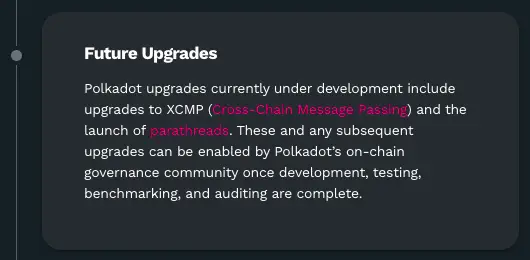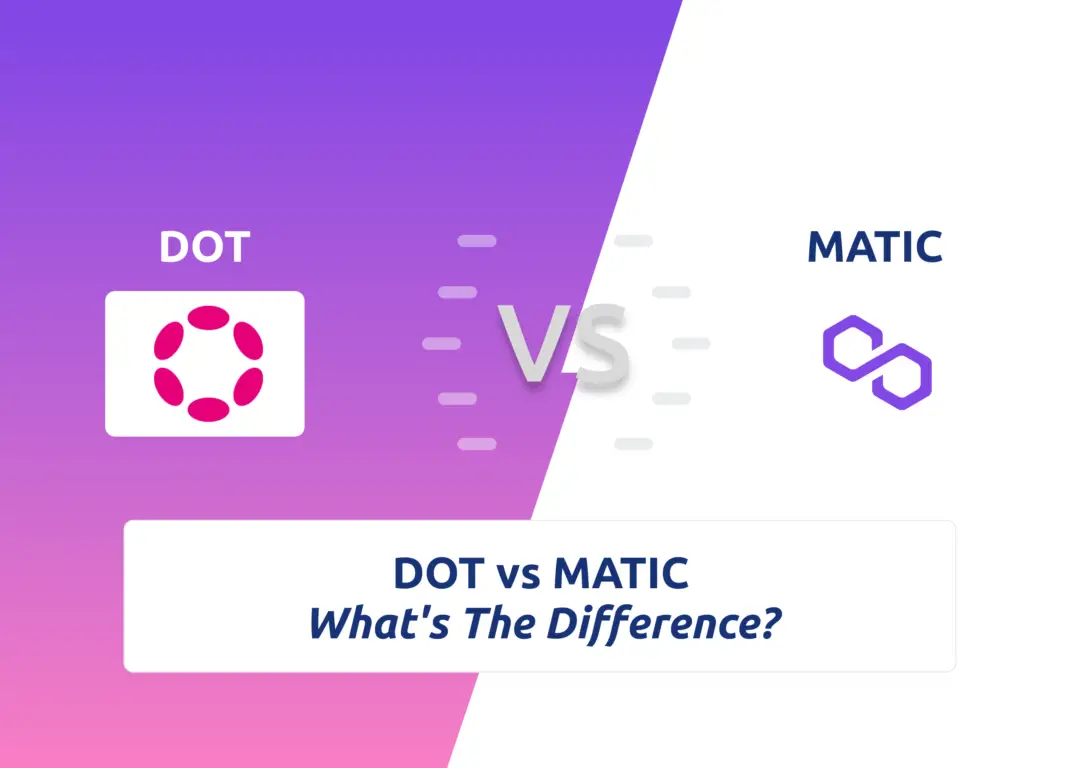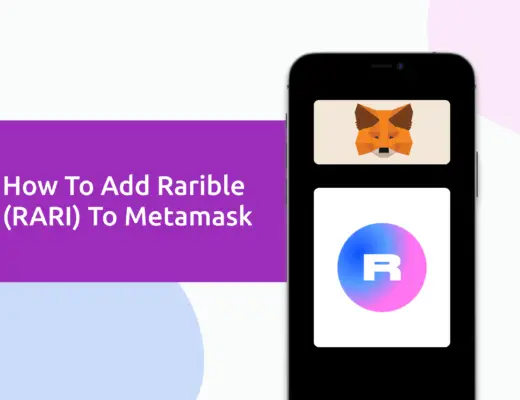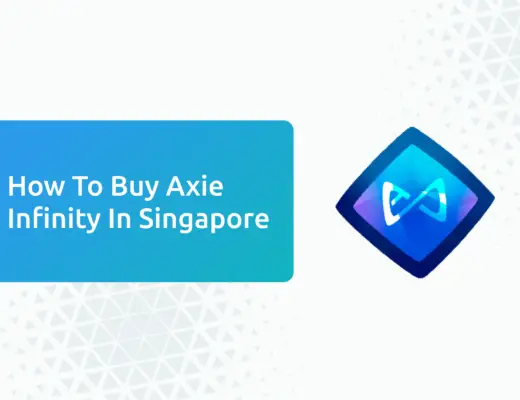Polkadot and Polygon: other than their similar names, these two networks are similar in their goals to scale blockchain networks.
As the number of blockchains is growing exponentially, these blockchains are becoming more and more fragmented.
They do not communicate with each other. Both Polkadot and Polygon are working towards interoperability. In this case, they are striving to be the “the Internet of Blockchain”, making blockchains more connected. Let’s explore the difference between these seemingly similar coins, Polkadot and Polygon!
Contents
The difference between DOT and MATIC
DOT can work with any network through parachains. However, Polygon is only compatible with Ethereum networks through sidechains. DOT is a layer 0 solution while MATIC is a layer 2 solution. Despite their differences, both networks strive to make the existing blockchain more scalable.
Main Network Functions
Polkadot network uses parachains
Imagine each chain as a train. Each train runs on only one track. Polkadot provides the tracks and stations that connect the different train services.
Source: Tina Nord from Pexels
Right now, different blockchains are like trains without an interchange station. Trains can function on their track but don’t communicate or exchange with the other train services.
Parachains allow for fast transactions as the distribution is efficiently spread to handle workloads.
The ability of parachains, according to CoinMarketCap
Polkadot aims to be the internet of blockchains.
Polkadot helps to connect the different chains into one system, which makes it a Layer 0 solution. This increases the scale of the current blockchains easily and hence, solves the scalability problem in many blockchains.
- Layer 0 is the network that runs beneath blockchain and connects blockchains.
- Layer 1 is the basic and usual chains that we know of, such as Bitcoin and Ethereum.
- Layer 2 is built upon Layer 1, without changing the underlying layer. Layer 2 helps Layer 1 to scale better while enjoying the security that Layer 1 offers.
Some examples include Polygon (MATIC) and Arbitrum.
Polygon network uses Plasma Chains
Interestingly, Polygon is also solving the same scalability problem, but with a different solution.
Polygon is a Layer 2 chain that scales Ethereum, which is a Layer 1 chain.
The most common problems of Ethereum blockchain are:
- High transaction costs (also known as gas fees)
- Slow processing speed
- Poor user experience
Polygon was created to solve these problems, as described in their original white paper. At the same time, the network can make use of Ethereum’s existing ecosystem and decentralised features.
How the Polygon network works
The key to Polygon’s network is its Plasma framework, which uses plasma bridges.
Plasma bridges help to move assets between the main chain and side chains. Root chains (or main chains) can be seen as Layer 1 while child chains are Layer 2.
If Polkadot is like a train interchange, then Polygon is like expressways for cars.
Photo by sergio souza from Pexels
Like expressways on the roads, Polygon provides a faster and alternative path than normal paths. If the Ethereum network is congested like a traffic jam, a user move their asset from Ethereum to the Polygon child chains (or sidechains) and transact there instead.
To transfer an asset such as a non-fungible token (NFT), the process takes place with the following steps:
- Transfer assets from the main chain to side chain
- Lock assets on the main chain
- Duplicate assets on the side chain
- Transfer within the side chain
- “Destroy” assets on the side chain
- Unlock assets on the main chain
Essentially, this is what the Plasma framework is about.
So, what’s the difference?
Both networks claim to be the internet of blockchain. The key difference is that MATIC can only scale up the Ethereum network while Polkadot can scale up networks, regardless of whether it is built on the Ethereum network.
Moreover, Polygon makes use of the security and user base of Ethereum networks to value add their network.
Main Coin Functions
There is a difference between the network and coin. Usually, coins are the currency that facilitates transactions on the network.
Let’s explore the functions of the two coins:
Polkadot coin (DOT) allows you to vote, nominate and validate
What can you do with DOT?
Other than buying and holding the coin, you can also participate in the other activities on the chain.
There are 3 main activities you can participate in with DOT:
- Vote
- Nominate
- Validate
Vote: Holders get complete control over the protocol
With DOT tokens, you can vote like a shareholder in a company. DOT holders could vote to decide on the latest projects.
For example, DOT holders could vote for their latest logo.
Source: Polkadot
This initiative gives DOT holders a voice in updating the Polkadot brand by casting a vote for their brand identity and logo design of preference.
Polkadot on their campaign
Nominate and Validate: Getting rewarded for being a good network user
There are many ways to stake Polkadot.
You can stake on:
- Polkadot-JS UI (which is what we are explaining in this section.)
- Parachains
- Ledger Live
- other staking platforms
There are two contributors to staking on Polkadot-JS UI: Validators and Nominators.
Validators are the ones who are actively producing blocks on the chain, running the network.
Nominators take up a more passive role. They vote for who they want to be the validators. To do this, they have to do their due diligence on the validators.
Source: Web3 Research
Good validators get to keep their stake by validating the correct transactions.
However, bad validators could harm the network by
- running modified software
- hacking the network
- being unresponsive
As a result, bad validators will forfeit a fixed percentage of their staked coins.
This forfeit is also known as slashing.
Nominators also lose a portion of their staked coins due to bad validators. Thus, to prevent losing their coins, both validators and nominators have to follow the network rules.
This staking system adopted by Polkadot is called Nominated Proof of Stake (NPoS).
NPoS creates a trusted network on Polkadot by rewarding good contributors while punishing bad contributors.
By staking as a validator or nominator, you earn an interest rate as well. This will be discussed in the investment value section below.
Polygon (MATIC) coins allow you to pay fees, validate and delegate.
While the network is called Polygon, the coin is known as MATIC.
Polygon is to Matic as Ethereum is to ETH.
CoinDesk
What Is the Role of the Matic Token?
It is a method of payment on the Polygon network. To perform tasks like creating an asset on the sidechains, the users have to pay transaction fees, which are in MATIC coins.
Similar to Polkadot’s system, there are validators and delegators (which are called nominators in Polkadot). These two parties are stakers. If they violate the rules of the network, they will be punished and their coins will be forfeited.
Validators and delegators secure the network by staking their MATIC in the staking contracts, which are used to achieve consensus and ensure the security of the network.
Polygon Official Website
Earning Through Staking Coins on Platforms
A great way to earn passive income is to stake coins on platforms and receive interest. It is also easy to set up and beginner-friendly.
Let’s compare the interest rates across the different platforms:
Staking DOT on platforms
| Platforms | Interest Rate (per year) |
|---|---|
| Binance | 11.51%, DOT locked for 30 days 14.21%, 60 days 16.62%, 90 days |
| Crypto.com | 6.0%– 14.5%, depending on the staked amount and staked duration |
| Kraken | 12% |
| Ledger Live | about 10%, after deducting validator’s fees |
| Gemini | Not available |
| BitFinex | Up to 7% |
There are many ways to stake Polkadot on the native platform. The most notable platform here is Ledger Live as it is directly affiliated with the Polkadot platform.
However, the minimum amount of staked Polkadot on Ledger Live is 120 DOT, which is a higher minimum than usual. Currently, 120 DOT is close to US$3000.
Source: Polkadot
The other platforms offer similar rates without having to stake a minimum of 120 DOT but have other conditions.
For Binance, it is about how long the coins are staked on the platform, from 30 days to 90 days.
As for Crypto.com, it depends on 2 conditions:
- The amount of staked of Crypto.com coin (CRO), ranging from 400 CRO to 4000 CRO
- Duration of stake (flexible, 1-month and 3-month stake)
The most straightforward option would be Kraken, which offers 12% for DOT stakes, without additional conditions.
Staking MATIC on platforms
| Platforms | Interest Rate (per year) |
|---|---|
| Binance | 11.34%, MATIC locked for 30 days 12.2%, 60 days 14.09%, 90 days |
| Crypto.com | 6.0%– 14.0%, depending on the staked amount and staked duration |
| Kraken | Not available |
| Ledger Live | Not available |
| Gemini | 2.02% |
| BitFinex | Up to 41% |
Unlike Polkadot, you are not able to stake your MATIC coins on Ledger Live. You can only transfer your coins onto Ledger Live, but not stake to earn interest.
The most straightforward option to stake MATIC is on Gemini. It offers a yearly interest rate of 2.02% without many conditions.
For Crypto.com, the range of interest rates is similar to that of Polkadot, which is around 6% to 14.0%. You can get the highest interest rate by staking 4000 Crypto.com coins (CRO) on their platform and for stake for 3 months.
As for staking on Binance, the minimum locked amount is 1 MATIC and there are limited slots for staking MATIC. The stake may be sold out, like in the screenshot below.
Source: Binance
On MATIC’s latest collaboration with BitFinex, the staking rewards for MATIC is up to 41% annually.
Bitfinex has received 90 million MATIC from Polygon to sponsor enhanced staking rewards for Bitfinex users.
BitFinex’s Press Release
There is no minimum staking amount but there is a minimum staking reward of about US$0.50. More information can be found on BitFinex’s website.
Earning Money Through the Network
Staking is stable and less risky but the interest rates are limited. If you are looking for higher returns while willing to take higher risks, you can also earn money through the Polkadot and Polygon networks.
These two networks have the most straightforward method of earning money through staking on the network directly.
Let’s explore the options in the section!
Polkadot – Stake on Parachains
On the Polkadot network, the most common way to earn is to be a nominator or validator. Since the steps of being a validator and nominator are well described by Polkadot, we shall talk about investing in Polkadot through parachains.
On Polkadot, DOT holders can stake their tokens to a parachain project. This concept is similar to that of an ICO, except that the supporters of the project can only stake DOT tokens.
Source: HoldPolkadot
DOT holders can lock in their tokens to support a project that they believe should be hosted on a parachain. The project developer will often incentivise bidding on their application by offering airdropped tokens or other rewards. However, these projects are lengthy and the staking period is usually 2 years, compared to the normal 30 – 90 days stake. If you intend to invest in DOT for a longer period, this may be a better option.
Polygon – Stake on Network
Earning money on the Polygon network is similar to Polkadot’s system. Delegators stake their tokens with a validator and both parties receive rewards.
If the participating members of the system are violating the rules, their coins get forfeited.
The average earnings are 4.5% – 5% per year for being a delegate or validator.
The exact percentage you earn will depend on several factors. These factors could give you a higher reward:
- A high number of people staking Polygon
- Coins that have been in the wallet for a long time
- A high number of blocks generated by the wallet
- Lower transaction fees
The best-case scenario is that you earn 8% per year, but this will only happen if the network volume and transaction fees are low. You can expect to earn between 2% and 4% per year in most cases.
The Tech Trend
For a detailed guide on how to stake on the Polygon network, here is a full guide on how to through Metamask.
Most Anticipated Projects
For long term investments, it is crucial to know the roadmap for the coin and network.
Here are key future developments for both coins:
Polkadot – Future Plans
The most exciting development on DOT is the launch of parathreads.
Building on the parachain network, parathreads allow new chains to join with less effort.
This is done through economically sharing the scarce resource of a parachain slot among several competing resources (parathreads).
Polkadot, on their parathread project
Simply put, it is a pay-as-you-go model where chains can use parachains by blocks.

Source: Polkadot
This is exciting as it allows chains to be interconnected without high upfront costs, allowing smaller projects to be connected to the bigger network as well.
Wide adoption of Polygon
In an interview, Polygon’s co-founder, Jaynti Kanani, revealed that Polygon is used by the government of Maharashtra (the second-most populous state in India). Results of the COVID tests can be verified through Polygon.
So many people are using Polygon, but maybe they don’t know it.
Jaynti Kanani, Polygon’s co-founder
The network has a wide adoption. Thanks to the network effect of Ethereum, Polygon has a wide reach. Thus, it has a huge potential to work on various projects and grow in the long term.
In 2022, Polygon enabled users to burn their tokens. This means destroying their coins and reducing the supply of circulating MATIC in the ecosystem.
Why would they do this?
This process, known as EIP-1559, makes the coins deflationary.
“Deflationary pressure causes the base fee to increase automatically if the block is full, the changes will result in fewer spam transactions and lead to less network congestion,”
– Polygon team
This highly-anticipated move benefits both validators and delegators.
Source: Polygon Burn
So, what’s the difference?
Admittedly, the two networks are similar.
According to the co-founder of Polygon, Sandeep Nailwal, Polygon is working only focusing on building better interoperability on Ethereum, which is a different approach from Polkadot.
When asked about the difference, Nailwal responded with:
“We are interoperable, but within Ethereum. A good mental model is to think of Polkadot as being in the center of a nest of parachains. With Polygon, the Ethereum chain is in the center with an array of Polygon chains around it. That’s why some people call it ‘Polkadot on Ethereum.’”
Management Team
Gavin Wood and Polkadot
Polkadot was founded in 2016 by Gavin Wood.
Perhaps he is not as well known as Satoshi Nakamoto or Vitalik Buterin but Dr Gavin Wood was a co-founder and key programmer in Ethereum during its early stage. He invented the Solidity language for writing the Ethereum smart contracts that we are familiar with today.
Decentralization and security are not optional in the search for scalability.
Gavin Wood, on Parity Technologies and Polkadot
Polkadot is managed by Web3 Foundation based in Zug, Switzerland and built by Parity Technologies.
It is also important to analyse the coin supply and the allocated coins to the management. Polkadot had several rounds of fundraising and the chart below shows a general breakdown of the allocation of coins:
Source: Messari.io
To breakdown the allocation further, here is a table to better examine the coin supply:
| Percentage allocated | Coin allocation |
|---|---|
| 50% | Sold to token investors |
| 30% | Assigned to the Web3 Foundation for the immediate development of the Polkadot network and other undisclosed Foundation activities. |
| 11.60% | Reserved by the Web3 Foundation for future fundraising |
| 5% | Sold to 2019 private sale investors |
| 3.40% | Sold to 2020 token sale investors |
Source: Messari.io
More than 50% of the coin supply is being used for the development of the network and is owned by the foundation.
India’s first crypto billionaires and Polygon
Matic network is based in India and was founded in October 2017.
Its founders are India’s first crypto billionaires, namely Jaynti Kanani, Sandeep Nailwal and Anurag Arjun. They were joined by Mihailo Bjelic.
Source: CoinDesk
Polygon was rebranded from Matic Network in February 2021. This is why the coin kept its name MATIC, while the company has been rebranded to Polygon.
The most notable partnerships with Polygon includes Decentraland, Chainlink and MakerDAO, which are relatively big projects in blockchain.
Polygon’s latest high-profile investor is Mark Cuban, who is a billionaire owner of an NBA team. You may have heard of him as an investor on the TV show, Shark Tank. He was a frequent user of the Polygon network before being an investor.
These factors make Polygon more credible as a company to invest in.
Final Verdict
| Factors | Polkadot (DOT) | Polygon (MATIC) |
|---|---|---|
| Network | Parachain | Plasma/Sidechains |
| Layer | Layer 0 solution | Layer 2 solution |
| Purpose | Improving the scalability of side chains | Improving the scalability of Ethereum based applications |
| Year of Establishment | 2016 | 2017 |
| Coin Function | Vote, nominate, validate | Pay, delegate, validate |
| Best interest rate for staking | 16.62% on Binance, staked for 90 days | Up to 41% on BitFinex (for a limited promotion period) |
| Earning through the network | Staking on a side chain through nomination or validation | Staking directly on Polygon through delegation or validation |
| Future Plans | Parathreads | Wide adoption, deflationary pressures by burning tokens |
| Background of founders | Gavin Wood, co-founder of Ethereum | Jaynti Kanani, Sandeep Nailwal and Anurag Arjun. They were joined by Mihailo Bjelic. |
Despite their similarities, there are slight differences to consider when investing in these coins.
The two companies have founders with heavy technical backgrounds, which allows them to be hands-on when developing the products.
Which of the coins is more suitable for you?
Choose Polkadot if you prefer more staking options or a high degree of decentralisation
There are more than four ways to stake your DOT through the network. You can choose to stake your coins as a nominator, as a validator, on parachains, on auctions and other platforms.
DOT is one of the most decentralised networks and the team is highly dedicated to ensuring that it stays decentralised.
However, the coin is less intuitive than most consumer-oriented coins. There are many functionalities and some technical background is helpful to navigate through the website.
Choose Polygon if you have transactions or develop dApps on Ethereum
As long as your assets are in the Ethereum network, you can benefit from the convenience and speed of the Polygon network.
Regardless of its success in the retail sector, the Polygon network is mainly aimed at improving the experience of developers. If you are a developer on Ethereum, Polygon is extremely useful to create decentralised apps (dApps) that are faster and cheaper than on the main Ethereum network.
However, if your assets or your products are not in the Ethereum network, you will not be able to make use of the Polygon network. Polygon currently does not support dApps that are not on the Ethereum network. It also has no plans of expanding outside of Ethereum.
Conclusion
Polkadot and Polygon are similar projects that help to scale blockchain. In the direction of building an interoperable blockchain network, the two networks don’t have to compete with each other. Rather, they have their niches and add value to the blockchain space as a whole.
Both are promising projects that are worth keeping an eye on in the years to come!

Do you like the content on this blog?
To receive the latest updates, you can follow us on our Telegram channels (Personal Finance or Crypto) and Facebook.
Are you passionate about personal finance and want to earn some flexible income?





